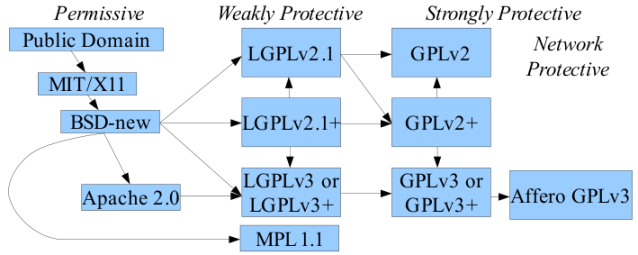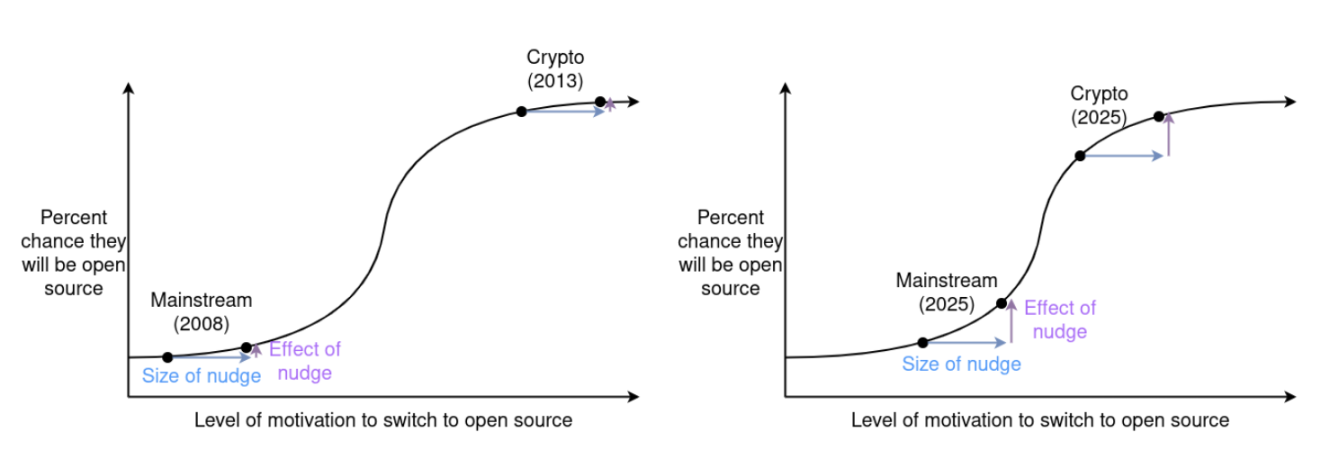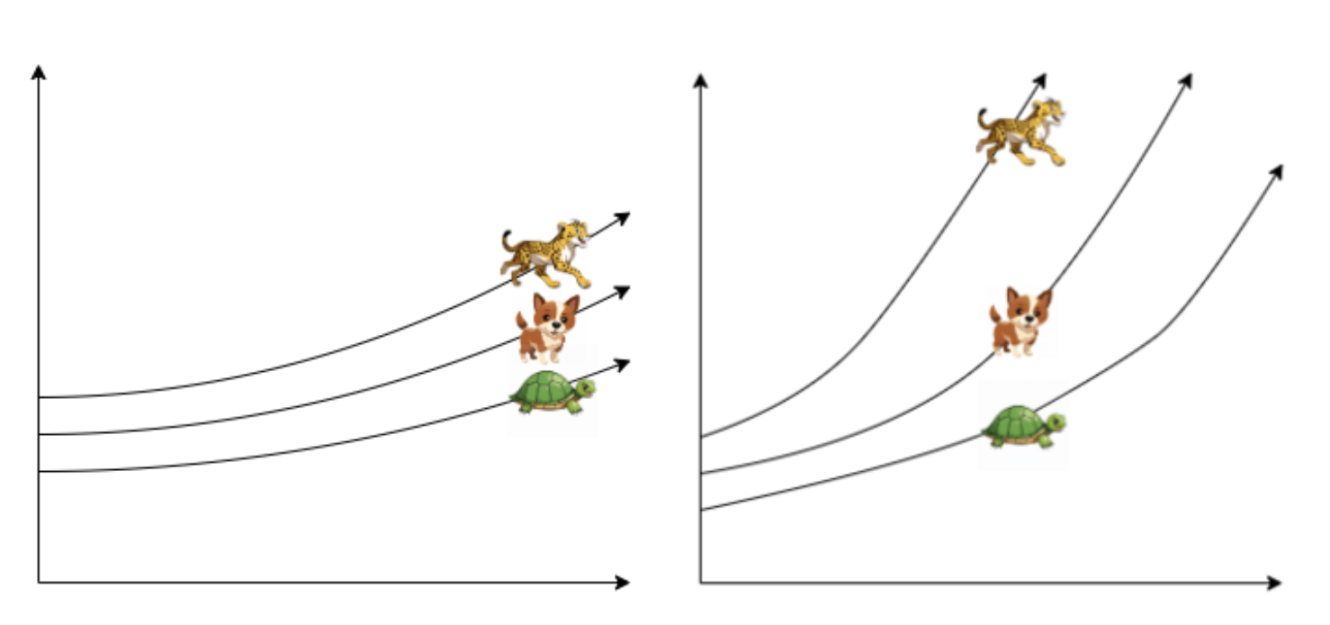Projects that chose permissive licenses back then should at least consider shifting to copyleft today.
Written by: Vitalik Buterin
Translated by: Saoirse, Foresight News
In the realm of free and open-source software (and more broadly, free content), copyright licenses are mainly divided into two categories:
If content is released under a permissive license (such as CC0, MIT), anyone can freely access, use, and redistribute that content without any restrictions, as long as they comply with the minimum requirement of attribution;
If content is released under a copyleft license (such as CC-BY-SA, GPL), anyone can also freely access, use, and redistribute copies, but if they create and distribute derivative works by modifying or combining it with other works, the new works must be released under the same license. Additionally, the GPL requires that any derivative works publicly disclose their source code and meet several other requirements.
In short: permissive licenses allow free sharing with everyone, while copyleft licenses only share with those who are also willing to share freely.
Since I became aware of these concepts, I have been an enthusiast and developer of free and open-source software and free content, eager to build things I believe are useful to others. In the past, I preferred permissive licensing models (for example, my blog uses the WTFPL license), but recently I have gradually shifted to supporting copyleft models. This article will explain the reasons for this change.

The WTFPL advocates a philosophy of software freedom, but it is not the only paradigm.
Why I Once Preferred Permissive Licenses
First, I wanted to maximize the adoption and dissemination of my work, and permissive licenses explicitly state that anyone can create based on my work without worrying about any restrictions, which conveniently facilitates this. Companies are often reluctant to open-source projects for free, and I know I cannot push them to fully transition to the free software camp, so I wanted to avoid unnecessary conflicts with their established and unwilling-to-give-up models.
Second, on a philosophical level, I generally dislike copyright (and patents). I do not agree with the notion that two people sharing data privately could be seen as a crime against a third party. They have neither touched nor interacted with the third party, nor have they deprived it of any rights (it should be noted that "not paying" is different from "theft"). Due to various legal factors, explicitly releasing works into the public domain is operationally quite complex. A permissive license is the purest and safest way to come as close as possible to a state of "not claiming copyright."
I do appreciate the copyleft idea of "using copyright to enforce copyright," which I think is a clever legal concept. In a sense, it resonates with the liberalism I advocate on a philosophical level. As a political philosophy, liberalism is often interpreted as prohibiting the use of any violence except to protect people from violent harm. As a social philosophical idea, I often see it as a way to tame humanity's aversion to harmful reflexes, elevating freedom itself to a sacred status, making actions that tarnish freedom repugnant. Even if you find the unconventional relationships between individuals uncomfortable, you cannot pursue them because interfering in the private lives of free individuals is itself detestable. Therefore, in principle, there are historical precedents that prove that aversion to copyright and the practice of "using copyright to enforce copyright" can coexist.
However, although the copyleft of textual works fits this definition, the GPL-style code copyright has transcended the minimalist concept of "using copyright to enforce copyright": it uses copyright for the aggressive purpose of "forcing the disclosure of source code." Although this is done in the public interest rather than for the selfish motive of collecting licensing fees, it still constitutes an aggressive use of copyright. This is even more pronounced for stricter licenses like the AGPL: even if derivative works are provided solely through software as a service (SaaS) and never made public, they are still required to disclose their source code.

Different types of software licenses set different conditions for sharing the source code of derivative works. Some licenses require the source code to be made public in a wide range of scenarios.
Why I Now Prefer Copyleft
My shift from favoring permissive licenses to supporting copyleft stems from two industry transformations and a philosophical change.
First, open source has become mainstream, making it more feasible for companies to embrace it. Nowadays, many companies across various industries are adopting open source: tech giants like Google, Microsoft, and Huawei not only accept open source but also lead the development of open-source software; emerging fields like artificial intelligence and cryptocurrency are more dependent on open source than any previous industry.
Second, competition in the cryptocurrency space has intensified, and the profit-seeking nature has increased, making it no longer possible to simply rely on goodwill for people to open source. Therefore, promoting open source cannot rely solely on moral appeals (like "please open the code") but must also leverage the "hard constraints" of copyleft, which only grants code access to developers who are also open source.
To visually present how these two forces enhance the relative value of copyleft, it can be roughly illustrated as follows:

In a scenario that is neither completely unrealistic nor necessarily feasible, the value of incentivizing open source is most significant. Currently, the mainstream corporate sector and the cryptocurrency industry are in this state, greatly enhancing the value of incentivizing open source through copyleft.
(Note: The horizontal axis represents the motivation level for transitioning to open source, while the vertical axis represents the probability of open source. The comparison of the two graphs shows that the motivation and effect of promoting open source through copyleft in the current mainstream sectors are more likely to work in synergy, while the cryptocurrency sector experiences diminishing marginal returns due to ecological maturity, reflecting the changing value logic of copyleft in incentivizing open source as the industry evolves.)
Third, the economic theory of Glen Weyl convinces me: in the presence of superlinear scale returns, the optimal policy is not a strict property rights system like Rothbard/Mises. On the contrary, the optimal policy indeed requires a certain degree of proactive promotion of projects to make them more open than they would be otherwise.
Fundamentally, if we assume the existence of economies of scale, simple mathematical reasoning makes it clear that a non-zero degree of openness is the only way to prevent the world from ultimately being controlled by a single entity. Economies of scale mean that if the resources I have are twice yours, the progress I can achieve will exceed twice yours. Thus, by next year, my resources might become 2.02 times yours, and so on…

Left image: Proportional growth model, where slight differences in the initial stage ultimately maintain a small gap; right image: Economies of scale growth model, where slight differences in the initial stage evolve into a huge gap over time.
From a historical perspective, the key factor in curbing this trend of imbalance is that humanity cannot escape the diffusion effect of progress. Talent carries ideas and skills as it flows between companies and countries; poor countries can achieve catch-up growth through trade with rich countries; industrial espionage is common, making it difficult for innovation to be absolutely monopolized.
However, in recent years, multiple trends have threatened this balance while weakening the traditional factors that curb imbalanced growth:
Technological progress is accelerating at an exponential rate, with the speed of innovation iteration far exceeding the past;
Political instability within and between countries is increasing: if the rights protection mechanism is sound, the rise of others does not directly pose a threat; but in an environment where coercive actions are more likely to occur and are difficult to predict, the excessive strength of a certain entity can become a substantial risk. Meanwhile, governments' willingness to regulate monopolies has decreased compared to the past;
Modern software and hardware products have the ability to be closed: traditional product delivery necessarily accompanies technical transparency (such as reverse engineering), but now closed-source products can only open usage rights while retaining modification and control rights;
The natural limitations of economies of scale have been weakened: historically, large organizations were limited by high management costs and difficulties in meeting localization demands, but digital technology has made super-large-scale control systems possible.
These changes have exacerbated the ongoing and even self-reinforcing power imbalance between companies and countries.
Therefore, I increasingly agree that stronger measures are needed to proactively incentivize or enforce the diffusion of technology.
Recent policies from various governments can be seen as mandatory interventions for technology diffusion:
The EU's standardization directives (such as the latest mandatory USB-C interface) aim to dismantle closed ecosystems that are incompatible with other technologies;
China's mandatory technology transfer rules;
The U.S. ban on non-compete agreements (I support this policy because it forces companies to achieve "partial open source" through talent flow, although confidentiality agreements exist, they are often riddled with loopholes in practice).
In my view, the drawbacks of such policies often stem from their inherently coercive nature, which leads them to prioritize incentivizing types of dissemination that are heavily inclined toward local political and business interests. However, the advantage of these policies is that they can indeed incentivize a higher level of technology dissemination.
Copyleft builds a vast pool of code (or other creative works) resources that can only be legally used when users are willing to share the source code of the content developed based on those resources. Therefore, copyleft can be seen as a highly universal and neutral mechanism for incentivizing technology diffusion, capable of reaping the positive effects of the aforementioned policies while avoiding many of their drawbacks. This is because copyleft does not favor any specific entity and does not require a central planner to actively set parameters.
These views are not absolute. In scenarios aimed at "maximizing dissemination," permissive licenses still hold value. But overall, the comprehensive benefits of copyleft have far exceeded those of 15 years ago. Projects that chose permissive licenses back then should at least consider shifting to copyleft today.

Unfortunately, the meaning represented by the "open source" label today is entirely unrelated to its original intent. However, in the future, we may have open-source cars, and copyleft hardware may help realize this vision.
免责声明:本文章仅代表作者个人观点,不代表本平台的立场和观点。本文章仅供信息分享,不构成对任何人的任何投资建议。用户与作者之间的任何争议,与本平台无关。如网页中刊载的文章或图片涉及侵权,请提供相关的权利证明和身份证明发送邮件到support@aicoin.com,本平台相关工作人员将会进行核查。




